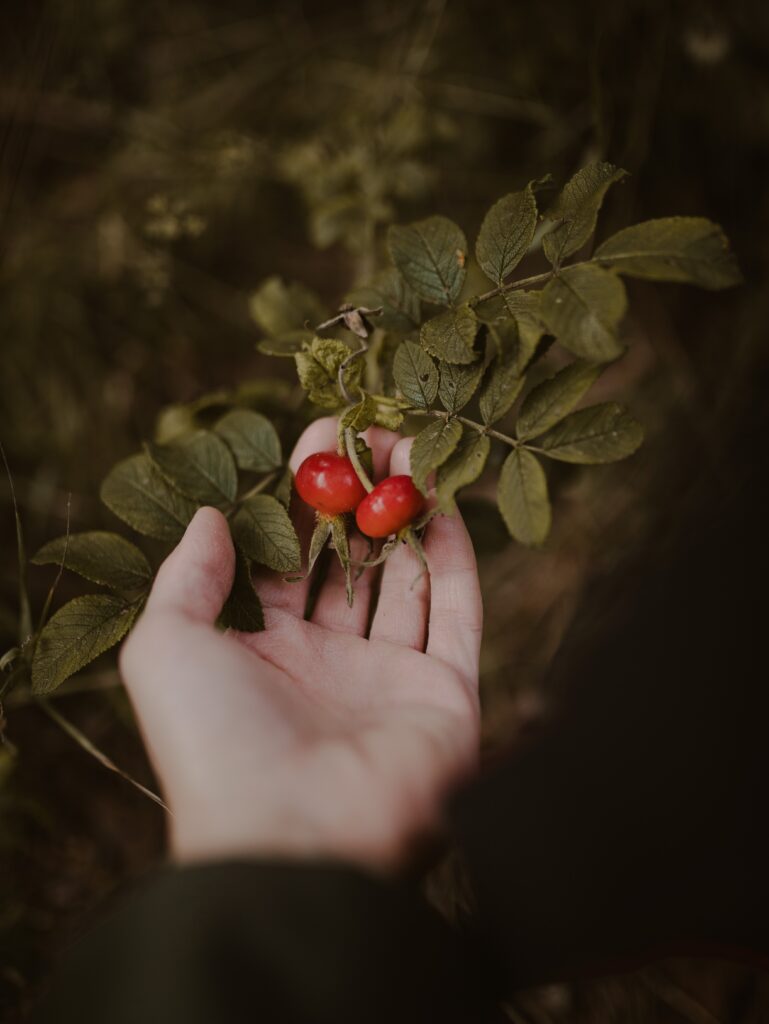By Jane Valencia
Once upon a time, the world changes. On an Island like this one, forest and mist reclaim the land, technology falls away, and certain names disappear. Calling out to her two children to come home, a mother puzzles in mid-holler as she forgets their names. Noticing the two bushes on either side of the front door, one red with rose hips and the other white with snowberries, she realizes that something of the rose is in one of her children, and something of the snowberry is in the other.
“Rose Hip! Snowberry!” Mam calls, naming them anew. And to her surprise and relief, they recognize the names in themselves, and come.
The two children must learn their world all over again. They set out on deer trails, a different one each day. Today’s trail leads to the edge of the woods.
“Look at that!” calls Rose Hip. Bordering the trail are two shrubs – one with red-orange rose hips and the other with bright, white snowberries. “Our namesakes. Into the woods we go!”
Snowberry hangs back.
“What?” Rose Hip says, impatient.
“In the old tales, deep red and bright white colors are signs of the Otherworld. The enchanted lands. The fairies.”
With a laugh, Rose Hip gestures in a circle. “This island? We’re already in Fairyland – or, a ‘no-ferry’-land. What’s a little more magic?” Grabbing Snowberry’s hand, Rose Hip leads the way.
Straight off, Snowberry notices the Red Alder trees. They are mottled gray, and their tall, long arms stretch over the trail, creating a forest hallway. Something about these big, old trees feels like being in the presence of grandparents, of many watchful elder beings. While Rose Hip darts ahead, Snowberry gives a timid wave to the trees.
An image unfurls in Snowberry’s mind: Mam, back home, slicing the roots, leaves, and twigs of Red Alder. Words breathe in Snowberry’s ear: Bear Medicine.
“Bear Medicine, what’s that?” Snowberry doesn’t know what Bear Medicine is, but several long scrapes mark a Red Alder trunk. The marks of Bear? The scrapes drip an orange-red substance. Resin.
“Oh –” Rose Hip is back beside Snowberry. Rose Hip touches the resin, then tastes it. “Yow! Super-bitter and super-dry. But … the flavor is also just the tiniest bit sweet.”
Plucking a zig-zag-edged leaf from the Red Alder, Rose Hip smears resin on it, and then marches down the trail, licking away at the leaf.
A chill replaces the warmth of the day. Snowberry’s stomach grows queasy. Snowberry gazes up at all those grandparent Red Alder trees, and senses a sternness in one, disapproval in another, sadness in a third, and gentle understanding in a fourth. In that moment, the trees seem so much like people that Snowberry stumbles back to the first Alder. Fumbling through the lunch that Mam had packed for them, Snowberry pulls out a chunk of cornbread and places it into a space in the trunk. That hollow is so much like a mouth – a tree mouth.
“For you.” Snowberry whispers. “Thank you for your resin. We both thank you.”
The leaves rustle, a quiet settles, and the chill lifts from Snowberry’s shoulders.
“Come on!” Rose Hip shouts.
With quiet and curiosity, Snowberry follows Rose Hip deeper into the forest.
To be continued.
Magical nature field notes:
Rose Hips (Rosa spp.): Rose Hips are the fruit of the Rose plant. High in Vitamin C and bioflavinoids, they are edible and medicinal – wonderful to include in syrups, teas, or foods during the cold and flu season. Be sure to harvest from plants that are free from chemicals and are from non-toxic areas. Remove the seeds before eating, as they have an irritating hairy covering.
Snowberry (Symphoricarpos albus): Don’t eat these berries! They’re poisonous. That said, this plant, with its bright white berries that last from winter into spring, and lacy foliage, is quite entrancing.
Red Alder (Albus rubra): Red Alder helps heal wounds, reduce inflammation, ease pain, and remove waste materials from the body. A poultice of the leaf can help draw out toxins from bites and stings. As a pioneer species, Red Alder helps fix nitrogen in the soil, thus improving the land for other plants. Rather than harvesting bark, a process that can injure the tree, harvest twigs for similar action.
Bear Medicine: In a number of Native American traditions, including the medicine ways taught for six years here on Vashon by Cherokee elder Nunutsi Otterson, Bear is considered an animal of healing, closely related to humans. Bears gather certain berries, roots, and barks – powerful medicines to cleanse the blood and organs on deep levels. With its own potent lymph-moving, blood-cleansing, anti-infective, and wound healing properties, as well as the physical expression of the blood-red layer of inner bark when exposed by scrapes (including bear clawing), Red Alder is quintessential Pacific Northwest Bear Medicine.
Resin: A gooey substance, resin helps safeguard the health of a tree. When a tree is wounded, resin beads up and coats the wound, forming a sticky, antiseptic “scab” over the wood to help prevent infection.
Signs of the Otherworld: In Celtic mythology, bright colors often signify that one is in the fairy realm or meeting a magical being. Bright red and pure white appear in the coloring of some Otherworld animals. Deer often lead one into the Otherworld.

